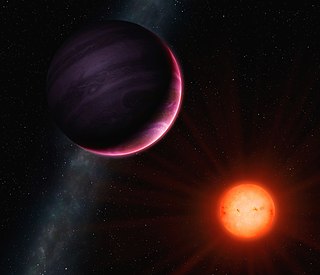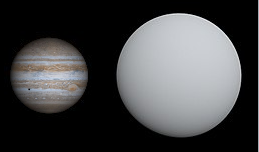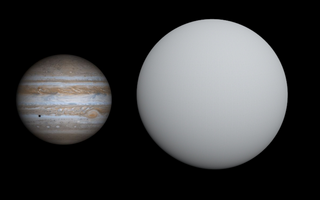
HD 149026 b, formally named Smertrios, is an extrasolar planet and hot Jupiter approximately 250 light-years from the Sun in the constellation of Hercules.
HD 118203 is a star located in the northern circumpolar constellation of Ursa Major. It has the proper name Liesma, which means flame, and it is the name of a character from the Latvian poem Staburags un Liesma. The name was selected in the NameExoWorlds campaign by Latvia, during the 100th anniversary of the IAU.

WASP-8b is an extrasolar planet orbiting the star WASP-8A in the constellation of Sculptor. The star is similar to the Sun and forms a binary star with a Red dwarf star (WASP-8B) of half the Sun's mass that orbits WASP-8A 4.5 arcseconds away. The system is 293 light-years (90 pc) away and is therefore located closer to Earth than other star systems that are known to feature planets similar to WASP-8b. The planet and its parent star were discovered in the SuperWASP batch -6b to -15b. On 1 April 2008, Dr. Don Pollacco of Queen's University Belfast announced them at the RAS National Astronomy Meeting.

Kepler-5b is one of the first five planets discovered by NASA's Kepler spacecraft. It is a Hot Jupiter that orbits a subgiant star that is more massive, larger, and more diffuse than the Sun is. Kepler-5 was first flagged as the location of a possibly transiting planet, and was reclassified as a Kepler Object of Interest until follow-up observations confirmed the planet's existence and many of its characteristics. The planet's discovery was announced at a meeting of the American Astronomical Society on January 4, 2010. The planet has approximately twice the mass of Jupiter, and is about 1.5 times larger. It is also fifteen times hotter than Jupiter. Kepler-5b orbits Kepler-5 every 3.5 days at a distance of approximately 0.051 AU.

Kepler-8b is the fifth of the first five exoplanets discovered by NASA's Kepler spacecraft, which aims to discover planets in a region of the sky between the constellations Lyra and Cygnus that transit their host stars. The planet is the hottest of the five. Kepler-8b was the only planet discovered in Kepler-8's orbit, and is larger than Jupiter. It orbits its host star every 3.5 days. The planet also demonstrates the Rossiter–McLaughlin effect, where the planet's orbit affects the redshifting of the spectrum of the host star. Kepler-8b was announced to the public on January 4, 2010 at a conference in Washington, D.C. after radial velocity measurements conducted at the W.M. Keck Observatory confirmed its detection by Kepler.

HD 4313 b is an extrasolar planet orbiting the K-type star HD 4313 approximately 447 light years away in the constellation Pisces. This planet was discovered using the Doppler spectroscopy method.

An exoplanet is a planet located outside the Solar System. The first evidence of an exoplanet was noted as early as 1917, but was not recognized as such until 2016; no planet discovery has yet come from that evidence. What turned out to be the first detection of an exoplanet was published among a list of possible candidates in 1988, though not confirmed until 2003. The first confirmed detection came in 1992, with the discovery of terrestrial-mass planets orbiting the pulsar PSR B1257+12. The first confirmation of an exoplanet orbiting a main-sequence star was made in 1995, when a giant planet was found in a four-day orbit around the nearby star 51 Pegasi. Some exoplanets have been imaged directly by telescopes, but the vast majority have been detected through indirect methods, such as the transit method and the radial-velocity method. As of 1 May 2023, there are 5,366 confirmed exoplanets in 3,962 planetary systems, with 856 systems having more than one planet. This is a list of the most notable discoveries.
Kepler-40b, formerly known as KOI-428b, is a hot Jupiter discovered in orbit around the star Kepler-40, which is about to become a red giant. The planet was first noted as a transit event by NASA's Kepler spacecraft. The Kepler team made data collected by its satellite publicly available, including data on Kepler-40; French and Swiss astronomers used the equivalent to one night of measurements on the SOPHIE échelle spectrograph to collect all the data needed to show that a planet was producing the periodic dimming of Kepler-40. The planet, Kepler-40b, is twice the mass of Jupiter and slightly larger than it in size, making it as dense as Neptune. The planet is also nearly thirteen times hotter than Jupiter and orbits five times closer to its star than Mercury is from the Sun.

The Next-Generation Transit Survey (NGTS) is a ground-based robotic search for exoplanets. The facility is located at Paranal Observatory in the Atacama desert in northern Chile, about 2 km from ESO's Very Large Telescope and 0.5 km from the VISTA Survey Telescope. Science operations began in early 2015. The astronomical survey is managed by a consortium of seven European universities and other academic institutions from Chile, Germany, Switzerland, and the United Kingdom. Prototypes of the array were tested in 2009 and 2010 on La Palma, and from 2012 to 2014 at Geneva Observatory.
Kepler-419b is a hot Jupiter exoplanet orbiting the star Kepler-419, the outermost of two such planets discovered by NASA's Kepler spacecraft. It is located about 3,400 light-years (1040 parsecs from Earth in the constellation Cygnus.

NGTS-1b is a confirmed hot Jupiter-sized extrasolar planet orbiting NGTS-1, a red dwarf star about half the mass and radius of the Sun, every 2.65 days. The NGTS-1 system is about 600 light-years from Earth in the Columba constellation.
Kepler-277c is the third most massive and second-largest rocky planet ever discovered, with a mass about 64 times that of Earth. Discovered in 2014 by the Kepler Space Telescope, Kepler-277c is a Neptune-sized exoplanet with a very high mass and density for an object of its radius, suggesting a composition made mainly of rock with some amounts of water. Along with its sister planet, Kepler-277b, the planet's mass was determined using transit-timing variations (TTVs).

NGTS-3Ab is a gas giant exoplanet that orbits a G-type star. Its mass is 2.38 Jupiters, it takes 1.7 days to complete one orbit of its star, and is 0.023 AU from its star. Its discovery was announced in 2018. The Jupiter-like planet is discovered by 39 astronomers, mainly Max Günther, Didier Queloz, Edward Gillen, Laetitia Delrez, and Francois Bouchy.

HD 102956 b or Isagel is an extrasolar planet discovered in 2010 by a team of American astronomers led by John Johnson using Doppler spectroscopy and the Keck Observatory in Hawaii. HD 102956 b is in the orbit of host star HD 102956. The planet is at most the mass of Jupiter, orbiting every 6.5 days at a distance of 12 million km. HD 202956 b has a very circular orbit. The system is roughly 399 light years from us.
TOI-677 b is a confirmed "warm" super-Jupiter exoplanet orbiting TOI-677, its host star, in the Ophiuchus constellation, about 466 ly (143 pc) away from Earth. The planet was discovered by NASA's Transiting Exoplanet Survey Satellite (TESS) using the transit method, in which the dimming effect that a planet causes as it crosses in front of its star is measured. Discovery of the exoplanet was announced on 13 November 2019.
Qatar-3 is a faint 12th magnitude star located in the northern constellation Andromeda. It is host to a transiting planet. With a radial velocity of 10.99 km/s, it is currently drifting away from the Solar System, and is currently located 2,400 light years away based on parallax.
Qatar-4 is a faint K-dwarf star that hosts a planet in the constellation Andromeda. With an apparent magnitude of 13.60, it is impossible to detect with the naked eye, but can be detected with a powerful telescope. Qatar-4 is currently located 1,083 light years away based on parallax.

TOI-4138b is a transiting exoplanet orbiting the G-type subgiant TOI-4138 1,674 light years away in the northern circumpolar constellation Ursa Minor.















